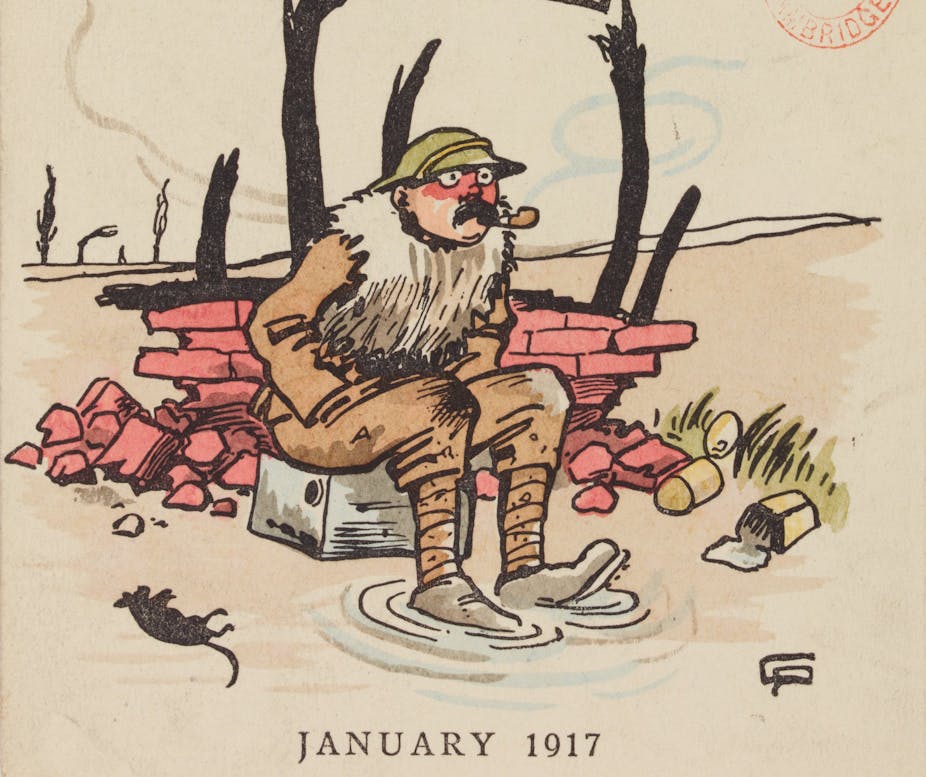In its new exhibition, the British Library celebrate the subversive history of the comic. As ever, such a complex heritage can hardly be covered in such a show. But it is a symptom of a more widespread movement: comics are starting to be recognised as far more than an ephemeral art form. They provide a rich source of cultural records of the past – a reflection, or projection of political and cultural feeling of the time.
This alternative cultural history provides particularly rich results in the case of World War I and II, which I have been researching in depth. Millions of people – children and adults – were avidly consuming comics at the time. Internal correspondence from The American Office of War Information (OWI) quotes Advertising Research foundation findings that approximate that 83% of Americans read at least one comic strip daily. And that:
Cartoons, advancing OWI campaigns, are distributed to an average of 1,000 newspapers weekly … Potential viewers are 60,000,000.
In situations of “total war” a range of organisations used comics to communicate with adults, not simply as a means of entertaining children. My research has searched for and recuperated thousands of different publications internationally, aimed at diverse audiences.

From the armed forces through to banned political parties and amateur efforts, the task of the comic strip in wartime became more focused. Comics were used for institutional messages, training manuals, as a way to communicate the needs of the demands of the home front. They were used to create collective loyalty and solidarity – of troops to their regiment, of workers to their trade union or political party, civilians to an ideal.
Comics were used to encourage public participation in campaigns for war loans, for instance. Comics encouraged children to collect pins, scraps and stamps for the war effort. “Addie and Hermy – The Nasty Nazis” appeared in the Dandy. Hitler and Goering made Simpsons-style appearances in the long running “Lord Snooty and his pals” strip, also in the Beano.
Comics occupy an odd position between fiction and reality. And it is this peculiar blurring between the fantasy narrative and that of the real war that increases the susceptibility of readers to the propaganda messages represented. So in wartime, comics helped vilify the enemy and promoted identification with the heroes, and all they represented.
This dichotomy of the hero and the villain, so intrinsic to comics, means that the medium lends itself naturally to a total war context. Many comic strip heroes directly contributed to the promotion of army recruitment by enlisting themselves in the armed forces, and this promoted normative ideals of masculinity. Such characters were drawn up as role models. They encouraged particular behaviour such as patriotism or correct social mores, while story lines manipulated stereotypes to further national war aims.

World War I soldiers, including those from Germany and France, published some 800 of their own newspaper-style publications in the field. But an aspect of this that has been largely overlooked is the fact that some of these also contained multi-panel cartoons. This wealth of content mostly functioned as satirical social observation by the men themselves about their own lives at the front and in the trenches.
The concerns of Australians, Canadians, New Zealanders, and British that emerge from their drawings were similar – food, drink, inadequate medical facilities, hierarchical military discipline and daily, seemingly pointless, routines. The intended readership was their peers, in the same battalion, unit or regiment, so these amateur cartoons capture the inside story, and in particular the stoic spirit of the army.
All of these early adult comic strips shared a collective purpose of morale boosting amongst the ranks. They used a kind of disparaging humour, portraying the long suffering soldier as a transnational everyman who endured in the service of Empire.
The catch phrase “we’re here because we’re here” epitomised a redefinition of courage as persistence. Courage entailed “sticking it out” rather than mutiny or desertion. And this anti-heroism in the armed forces’ own publications was in sharp contrast to the way they were portrayed back home – at the Home Front. Here, the media’s elevation of heroism understandably commemorated those who made the ultimate sacrifice, but was also aimed at encouraging further recruitment. It had the effect of raising expectations that were quickly dashed on arrival at the Front.
The disparagement humour at the Front, children’s comics, those advocating the war effort from home, and others which reflected and commented on social movements, all provide a unique opportunity to hit the pulse of wartime emotion. Such cartoons provide us with a cultural record that was spontaneous, of the moment, not driven by rose-tinted afterthoughts or reinterpretations composed after the passage of time.

